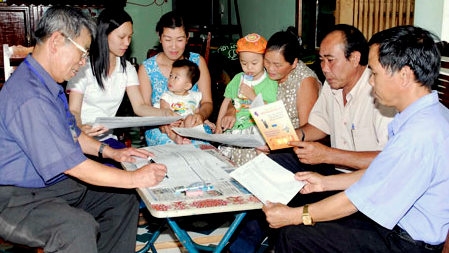Vietnam’s population and housing census is conducted every ten years on April 1 and the fifth survey will be conducted in 2019, aimed at meeting national targets and several indicators for sustainable development, heard a Hanoi workshop on September 7.

Local officials conduct the 2009 population and housing census in Thong Nhat ward, Pleiku city, in the Central Highlands province of Gia Lai on April 1, 2009. (Credit: baogialai.com.vn).
On Thursday morning, the General Statistics Office (GSO) of Vietnam, in collaboration with the United Nations Population Fund (UNFPA), held a workshop to discuss plan for the 2019 population and housing census.
Speaking at the event, GSO Director General Nguyen Bich Lam emphasised that the population and housing census in 2019 will aim to collect basic and detailed information on population and housing in Vietnam, making a basis for assessing the implementation of socio-economic development plans for the 2011-2020 period and developing socio-economic development policies for 2021-2030.
The results of the census would provide detailed data on national population size ten years after the 2009 survey, while supplementing the State and each locality’s database for further study, analysis and forecast population growth and housing development nationwide and in each locality, serving for international comparison requirements, said Lam.
The results of the 2019 census will also serve as a basis for initial assessment of implementation of the post-2015 UN Millennium Development Goals (MDGs), which Vietnam has already committed to, as well as building statistical databases on population according to the Statistics Law and being an important source of information to support the updating of the national database and the database of relevant ministries and agencies for the building of an e-government.
Astrid Bant, UNFPA Country Representative in Vietnam, said the 2019 census is an important one for the GSO as well as all organisations and individuals that will use its results, including policy makers, relevant ministries, private sector, civil societies, researchers and development partners.
Results from the census will also help the government monitor Vietnam's achievements towards MDG targets.
Vu Thi Xuan Mai, Head of GSO’s Population and Labour Statistics Department, said that the population and housing censuses have been conducted every ten years to collect information on population and housing in order to evaluate national targets and indicators of sustainable development.
The object of the investigation is all Vietnamese people with permanent residents.
Estimated content collected in the census in the next two years includes statistical information on traditional demographics and on housing and living conditions of households.
Statistical information is integrated to meet the requirements of compiling several statistical indicators which will reflect emerging or important issues in the field of population.
The basis for information collecting in the 2019 census includes the national statistical indicator system enacted by the 2015 Statistics Law, the statistical indicator system at provincial, district and commune levels; and sets of indicators on national development, youngsters, the Law on Vietnamese Children, and on socio-economic status of 53 ethnic minority groups across Vietnam.
Sharing local experiences from the 2009 census, Lam Le Bang, Deputy Director of Yen Bai provincial Statistics Office, said that to ensure effectiveness of the survey, the active participation of all levels, branches and socio-political organisations is important, in addition to selecting appropriate propaganda forms suitable to socio-economic characteristics of each locality.
It is estimated that Vietnam’s population by 2019 will be approximately 95.4 million throughout over 25.9 million households.
The 2019 survey will be carried out at over 173,000 locations, requiring the participation of more than 200,000 investigators and supervisors.
Nhan Dan